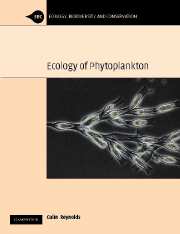Book contents
- Frontmatter
- Contents
- Preface
- Acknowledgements
- Chapter 1 Phytoplankton
- Chapter 2 Entrainment and distribution in the pelagic
- Chapter 3 Photosynthesis and carbon acquisition in phytoplankton
- Chapter 4 Nutrient uptake and assimilation in phytoplankton
- Chapter 5 Growth and replication of phytoplankton
- Chapter 6 Mortality and loss processes in phytoplankton
- Chapter 7 Community assembly in the plankton: pattern, process and dynamics
- Chapter 8 Phytoplankton ecology and aquatic ecosystems: mechanisms and management
- Glossary
- Units, symbols and abbreviations
- References
- Index to lakes, rivers and seas
- Index to genera and species of phytoplankton
- Index to genera and species of other organisms
- General index
Chapter 7 - Community assembly in the plankton: pattern, process and dynamics
Published online by Cambridge University Press: 07 August 2009
- Frontmatter
- Contents
- Preface
- Acknowledgements
- Chapter 1 Phytoplankton
- Chapter 2 Entrainment and distribution in the pelagic
- Chapter 3 Photosynthesis and carbon acquisition in phytoplankton
- Chapter 4 Nutrient uptake and assimilation in phytoplankton
- Chapter 5 Growth and replication of phytoplankton
- Chapter 6 Mortality and loss processes in phytoplankton
- Chapter 7 Community assembly in the plankton: pattern, process and dynamics
- Chapter 8 Phytoplankton ecology and aquatic ecosystems: mechanisms and management
- Glossary
- Units, symbols and abbreviations
- References
- Index to lakes, rivers and seas
- Index to genera and species of phytoplankton
- Index to genera and species of other organisms
- General index
Summary
Introduction
In the pelagic, as in the great terrestrial ecosystems, space is occupied by numbers of organisms of various species forming distinct populations fulfilling differing roles. Of course, these assemblages of species reflect autecological aspects of preference and tolerance but they also show many synecological features of the mutual specific interactions and interdependences that characterise communities. The numbers of organisms, the relative abundances of the species, their biological traits and the functional roles that they fulfil all contribute to the observable community structure. In the plankton and in other biomes, the challenge to explain how these structures are put together, how they are then regulated and how they alter through time, falls within the understanding of community ecology.
This chapter considers the structure of phytoplankton assemblages among a broad range of pelagic systems, in the sea and among inland waters, seeking to identify general patterns and common behaviour. In the second main section (7.3), the processes that govern the assembly of communities and shape their structures are traced in detail. Because some of the terminology has been used uncritically in the literature, sometimes erroneously and often confusingly, their usage in the current work is explained in a separate text (Box 7.1).
- Type
- Chapter
- Information
- The Ecology of Phytoplankton , pp. 302 - 386Publisher: Cambridge University PressPrint publication year: 2006
- 2
- Cited by

